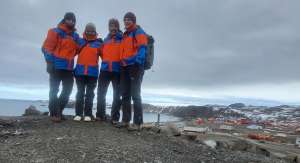With the aim of long-term monitoring of the biodiversity of the Southern Ocean, within the framework of the LIX Antarctic Scientific Expedition (ECA 59) of the Chilean Antarctic Institute (INACH), the Marine Observatory project of the BASE Millennium Institute was completed.
April 14, 2023.- With the installation of a Marine Observatory, the Millennium Biodiversity Institute of Antarctic and Sub-Antarctic Ecosystems (BASE) completed its scientific work in Antarctica during the 2022-2023 season in Fildes Bay. Using different sampling tools, it was sought to study the changes in the biodiversity of the Southern Ocean, monitoring that will continue to be developed in the coming years.
The team was led by the principal investigator of the Millennium Institute BASE , also from the University of Magallanes (UMAG) and the Cape Horn International Center (CHIC), PhD. Karin Gerard; and counted on the work of the academic of the University of Sorbonne and researcher of the Station Marine de Concarneau of the National Museum of Natural History of France, PhD. Cyril Gallut; the marine biologist from the Austral University of Chile (UACh) Vicente Villabolos; and the professional diver, Alberto Ahumada.
The Marine Observatory seeks to establish baselines of marine biodiversity, through different sampling methods: water filtration to obtain environmental DNA, the installation of an Autonomous Reef Monitoring Structure (ARMS), fishing trawling and autonomous diving. It is intended to cover a range of dimension and wide development, in order to monitor the dynamics of variation of marine diversity over ten years and see the effects of climate change.
Highlighting the impact of the scientific work carried out, PhD. Karin Gerard, also a researcher at the Laboratory of Antarctic and Sub-Antarctic Ecosystems (LmAS-UMAG), directed by PhD. Andrés Mansilla, explained that the environmental DNA obtained by the filtration of water from sea “allows detecting the presence of species without the need to collect them”, while with autonomous diving it is possible to reach organisms located up to 30 meters deep. On the other hand, “with the trawl you can get much deeper benthic macroorganisms, and with the ARMS facility, you can go as deep as 15 to 20 meters”, she said.

As indicated by PhD. Cyril Gallut, the ARMS were installed in the Ross Sea in Terra Nova Bay, and in the Dumont d’Urville Sea in the Pointe Géologie archipelago. “Thanks to an international collaboration we will be able to compare the biodiversity and settlement dynamics of benthic species at the level of the Southern Ocean,” he said.
ARMS are structures made of PVC plates that function as artificial reefs on which benthic flora and fauna settle. After one, two and three years, these ARMS will be removed to identify, by metabarcoding, the life that has developed in them. “Comparing different years we will be able to see the dynamics of recruitment of organisms”. They will be installed in two sites, Bahía Fildes and Yelcho, the first being more likely to receive exotic species due to intense maritime traffic”, explained the principal investigator of the BASE Millennium Institute.
“Antarctica has a unique biodiversity on the planet that has been little studied. As we have grown as a society we have increased the risk of disrupting it and therefore losing it forever. The Marine Observatory installed by the Millennium Institute BASE and PhD. Gerard is crucial in avoiding this catastrophe, since it allows us to generate detailed information about the communities that inhabit this vulnerable region and move towards its conservation”, expressed the UACh researcher, Vicente Villalobos. .
“It is very important to have a baseline as soon as possible, to be able to see the changes. See which species arrive and which, in the short or medium term, manage to establish themselves in the marine environment. It is essential to have this Observatory and to continue monitoring it over time”, said the Director of the Millennium Institute BASE, Dr. Elie Poulin.
This project is part of the “Observatory” line of research of the Millennium Institute BASE, whose objective is to contribute to improving knowledge about biodiversity in Antarctic and Sub-Antarctic areas and to initiate long-term monitoring of biodiversity through marine areas and terrestrial ecosystems. to detect significant changes as a consequence of climate changes induced by human activity.
By: Constanza Barrientos
Main picture: César Cárdenas

